
P1 - 2 digit Up/Down Counter using PIC16F628 and with alarm
Page 2 Adding Dice and Random Number (PIC16F628)
Page 3 2 digit Up/Down Counter using PIC12F629
Page 4 Adding RF Link to PIC12F629 version
Page 5 Car Gears Up/Down counter
Chip Programmer - PICkit2 from Modtronix (MPASM and MPLAB come with PICkit2)
2 Digit Up/Down Counter with PIC16F628 and prototype PC board $25.00 plus $6.50 postage.
To order the kit, [send an email](mailto:colin@elechelp.com?Subject=Buying components for the 2 Digit Up/Down counter&Body=Please e-mail the cost of components for the 2 Digit Up/Down counter on prototype PC board for $25.00 plus postage by air mail to my country:**___**** and send details of how I can pay for it. My name is:____)** to us and we will reply with the details of how to order etc.
[components](mailto:colin@elechelp.com?Subject=Buying components for the 2 Digit Up/Down counter&Body=Please e-mail the cost of components for the 2 Digit Up/Down counter on prototype PC board by air mail to my country:****___**** and send details of how I can pay for it. My name is:____) are available from Talking Electronics.
See more projects using micros:
- Elektor,EPE,Silicon Chip
- Notepad++ or VS Code
- Library of Sub-routines “Cut and Paste”
- Library of Routines:
The files for PIC16F628: See P1
The files for Dice for PIC16F628: See Page 2
- Dice.asm
- Dice.txt (asm)
- Dice.hex
- Dice-h.txt (.hex)
The files for UpDown/Dice/00-99 for PIC16F628: See Page 2
The files for UpDown for PIC12F629: See Page 3
This project comes via two circuits on 2 boards. The first circuit is designed around a PIC16F628A. It has been presented on an experimental PC board using surface-mount components and was built in less than 1 hour, with about 2 hours to write and finalise the program. See Page 1, Page 2
The second circuit uses a PIC12F629 to produce a 2-Digit Up/Down Counter (see Page 3).
Both use “In Circuit Programming” via PICkit-2.
Page 5 Describes the up/down counter displaying the “gear” for motorcycles and racing cars.
The project shows what can be done with a micro and you can modify it to set an alarm at any count-value or set a limit such as “count-to-60.” You can add a buzzer or relay or increase the display to 3 digits. You need to remember that each additional display will reduce the illumination of each digit as they are “multiplexed (time-sharing).”
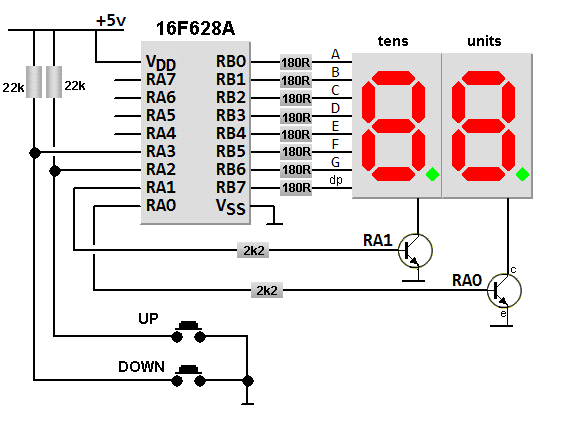
The Basic 2-Digit Up/Down Counter Circuit
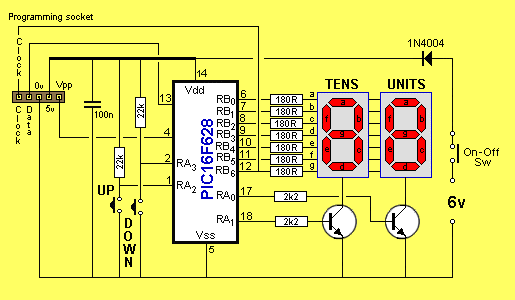
Full circuit diagram including programming socket
The displays do not affect the “In Circuit Programming” as they are not active when programming and do not load the outputs.
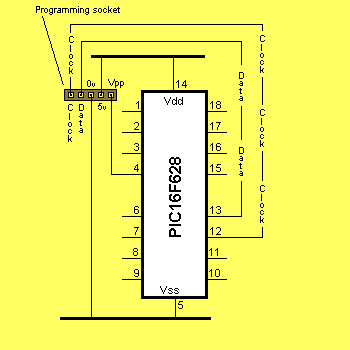
The “In Circuit Programming” Connections
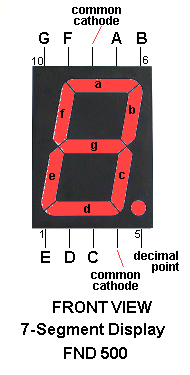
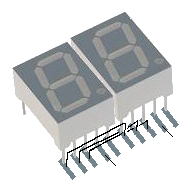
The two 7-Segment displays are paralleled by jumpers at the top and bottom
Any 7-Segment displays will work in this circuit. You need to identify the pinout of any display you use.
(Common Anode displays can be used providing you invert the values in the display table. A PNP transistor will need to be used.)
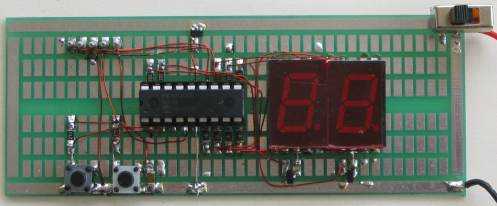
Photo of the 2-Digit Up/Down Counter
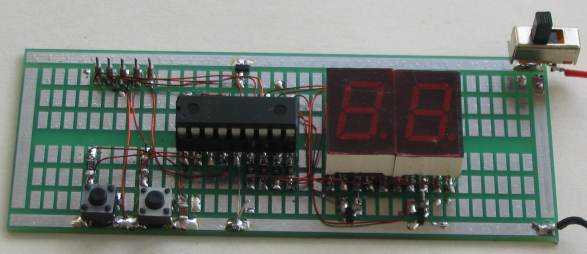
2 Digit up/down COUNTER
The experimenter PC Board shows the five “In Circuit Programming” pins and a diode on the positive rail to drop the 6v supply to 5.4v. The board also has a 100n surface mount capacitor and two surface-mount transistors. The Up/Down buttons have 22k resistors.
TESTING THE CIRCUIT
Check the circuit by removing the chip and taking pins 6 and 18 to the 5v rail ad make sure segment “A” illuminates. Do the same for all the other segments.
The circuit diagram does not have any voltages marked on it as the circuit is DIGITAL.
All the “lines” or “wires” or pins of a microcontroller will have rail voltage (5v) on them when they are HIGH and when you come to a resistor, the resistor will drop a certain voltage. The voltage it will drop will be the difference between rail voltage and the voltage developed across the component it is driving. If it is driving a LED, the LED will drop a characteristic voltage of between 1.7v and 3.6v, depending on the colour.
If the component is a transistor, the voltage developed between the base and emitter will be about 0.7v.
;****************************************************************
;* 2 Digit UP / Down Counter 17/6/2009
;Port B drives two 7 segment displays
;Up Sw on RA2 Down Sw on RA3
;"Units" drive on RA0 "Tens" drive on RA1
;* *
;****************************************************************
list P = 16F628A ;microcontroller
include ;registers for F628A
__Config _cp_off & _lvp_off & _pwrte_on &
_wdt_off & _intRC_osc_noclkout & _mclre_off
;code protection - off
;low-voltage programming - off
;power-up timer - on
;watchdog timer - off
;use internal RC for 4MHz - all pins for in-out
;****************************************************************
; variables - names and files
;****************************************************************
;Files for F628A start at 20h
temp1 equ 20h ;for delay
temp2 equ 21h ;for delay
SwUp equ 22h ;
SwDwn equ 23h ;
units equ 24h ;
tens equ 25h ;
Sw_Flag equ 26h ;
FastCount equ 27h ;counts loops fast incrementing
;****************************************************************
;Equates
;****************************************************************
status equ 0x03
cmcon equ 0x1F
rp1 equ 0x06
rp0 equ 0x05
portA equ 0x05
portB equ 0x06
trisA equ 0x85
trisB equ 0x86
;****************************************************************
;Beginning of program
;****************************************************************
reset org 00 ;reset vector address
goto SetUp
table addwf PCL,F ;02h,1 add W to program counter
retlw b'00111111' ; "0" -|F|E|D|C|B|A
retlw b'00000110' ; "1" -|-|-|-|C|B|-
retlw b'01011011' ; "2" G|-|E|D|-|B|A
retlw b'01001111' ; "3" G|-|-|D|C|B|A
retlw b'01100110' ; "4" G|F|-|-|C|B|-
retlw b'01101101' ; "5" G|F|-|D|C|-|A
retlw b'01111101' ; "6" G|F|E|D|C|-|A
retlw b'00000111' ; "7" -|-|-|-|C|B|A
retlw b'01111111' ; "8" G|F|E|D|C|B|A
retlw b'01101111' ; "9" G|F|-|D|C|B|A
;****************************************************************
;* port A and B initialisation *
;****************************************************************
SetUp bsf status,rp0
movlw b'00001100' ;Make RA0,1 out RA2,3 in
movwf 05h ;trisA clrf 06h ;trisB Make all RB output
bcf status,rp0 ;select programming area - bank0
movlw b'10000000' ;Turn off T0CKI
movwf option_reg
clrf portB ;Clear Port B of junk
clrf units ;zero the units file
clrf tens ;zero the tens file
clrf Sw_Flag
movlw 07h ;turn comparators off and enable
movwf cmcon ; pins for I/O functions
goto Main
;Delay 10mS 10 x 1,000uS
D_10mS movlw 0Ah
movwf temp2
D_a nop
decfsz temp1,f
goto D_a
decfsz temp2,f
goto D_a
retlw 00
Up btfsc Sw_Flag,2
retlw 00
bsf Sw_Flag,2
incf units,f
movlw 0Ah ;put 10 into w
xorwf units,w ;compare units file with 10
btfss status,2 ;zero flag in status file. Set if units is 10
retlw 00
clrf units
incf tens,f
movlw 0Ah ;put 10 into w
xorwf tens,w ;compare units file with 10
btfsc status,2 ;zero flag in status file. Set if tens is 10
clrf tens
retlw 00 ;display passes 99 but not below 0
Dwn btfsc Sw_Flag,3
retlw 00
bsf Sw_Flag,3
decf units,f
movlw 0FFh ;put FFh into w
xorwf units,w ;compare units file with FFh
btfss status,2 ;zero flag in status file. Set if units is 10
retlw 00
movlw 09
movwf units ;put 9 into units file
decf tens,f
movlw 0FFh ;put 0FFh into w
xorwf tens,w ;compare tens file with 0FFh
btfsc status,2 ;zero flag status file). Set if tens is 0FFh
goto $+2 ;tens file is 0FFh Jump down 2 instructions
retlw 00
clrf tens
clrf units
retlw 00 ;display not below 0
Main btfss portA,2 ;test switch-press for UP
call Up ;UP switch pressed
btfss portA,3 ;test switch-press for Down
call Dwn ;Down switch pressed
movlw b'00000001' ;Make RA0 HIGH for units drive
movwf portA movf units,f ;copy unit value into w
call table ;unit display value will return in w
movwf portB ;output units value
call D_10mS ;call delay
clrf portB ;clear display
movlw b'00000010' ;Make RA1 HIGH for tens drive
movwf portA movf tens,f ;copy tens value into w
call table ;tens display value will return in w
movwf portB ;output tens value
call D_10mS ;call delay
clrf portB ;clear display
btfsc portA,2 ;bit will be zero when sw is pressed
bcf Sw_Flag,2
btfsc portA,3 ;bit will be zero when sw is pressed
bcf Sw_Flag,3
goto Main
END
If you want to suppress (remove) the first “0” when the digits are 1, 2, 3, etc, here are the lines of code to add:
In the files section, add
;Files for F628A start at 20h compare equ 28h ;looks for "0" in first display
In Main, add the following lines shown in <--this:
Main btfss portA,2 ;test switch-press for UP
call Up ;UP switch pressed
btfss portA,3 ;test switch-press for Down
call Dwn ;Down switch pressed
movlw b'00111111' ;binary for "0" on the display <--this
movwf compare ;put the value into compare <--this
movlw b'00000001' ;Make RA0 HIGH for units drive
movwf portA
movf units,f ;copy unit value into w
call table ;unit display value will return in w
movwf portB ;output units value
call D_10mS ;call delay
clrf portB ;clear display
movlw b'00000010' ;Make RA1 HIGH for tens drive
movwf portA
movf tens,f ;copy tens value into w
call table ;tens display value will return in w
subwf compare,1 <--this
btfsc 03,2 ;test zero flag for match <--this
movlw 0 ;remove the zero on the display <--this
movwf portB ;output tens value
call D_10mS ;call delay
clrf portB ;clear display
btfsc portA,2 ;bit will be zero when sw is pressed
bcf Sw_Flag,2
btfsc portA,3 ;bit will be zero when sw is pressed
bcf Sw_Flag,3
goto Main
END
The program above uses very simple instructions and it is very easy to see how each line of code works. The only Boolean instruction is xorwf and this is an ex-or instruction (exclusive-or) which means two files are compared with each bit in one file compared with the same bit in the other file. The result is “1” when one (and only one) of the numbers is “1.” XOR detects a MATCH. If two identical numbers are compared, the answer for say the lowest bit will be “0” because only one of the numbers must be “1.” If both files contain the same value, the result of the XOR is “0.”
We now look at file 03, (the Status file) and check bit 2. This is the zero bit. The result of the XOR instruction is “0” and thus the zero bit is SET.
This is the the most complex of the instructions used in this program.
Now we come to a program written by a PROGRAMMER.
It performs the same as the program above and has the same number of instructions, but it contains a lot more Boolean instructions and this makes it a lot harder to understand.
However it is very interesting to see how to program at the “next level of understanding,” and we will cover some of the features (these are located after the program).
If you use any of the following .asm files and find they fail to produce a .hex file, make sure you have the .inc file in the same folder as the .asm.
To add RESET to the up/down counter, add the following instructions:
SetUp bsf status,rp0
movlw b'00011100' ;Make RA0,1 out RA2,3,4 in
Put reset on RA4 pin3
put 22k to positive and the switch between pin3 and 0v.
When sw is pressed the input will go low.
in main, the least few lines will be
bcf Sw_Flag,2 ;button not pressed. Clear Up flag
bcf Sw_Flag,7 ;Clear Up repeat flag
clrf FastCount
btfss portA,4 ;test reset
goto SetUp
goto Main
END
;******************************************************************
; 2-Digit Up/Dn Counter, Isochronous Loop Example
; Isochronous - to occur at equal time intervals. *
;******************************************************************
processor PIC16F628
include "p16f628.inc"
errorlevel -302
__Config _cp_off & _lvp_off & _pwrte_on &
_wdt_off & _intRC_osc_noclkout & _mclre_off
;code protection - off
;low-voltage programming - off
;power-up timer - on
;watchdog timer - off
;use internal RC for 4MHz - all pins for in-out
ones equ 0x20 ; 0..9
tens equ 0x21 ; 0..9
number equ 0x22 ; 00..99
swlatch equ 0x23 ; switch state latch variable
DelayHi equ 0x24 ; DelayCy() subsystem variable
#define DnSw 3 ; RA3
;******************************************************************
;
; DelayCy() subsystem macro generates four instructions
;
radix dec
clock equ 8 ; clock frequency in Megahertz
usecs equ clock/4 ; cycles/microsecond multiplier
msecs equ usecs*1000 ; cycles/millisecond multiplier
DelayCy macro delay ; 11..327690 cycle range
movlw high((delay-11)/5)+1
movwf DelayHi
movlw low ((delay-11)/5)
call uDelay-((delay-11)%5)
endm
;******************************************************************
;
; init hardware and program variables
;
org 0x000
Init
bsf STATUS,RP0 ; bank 1
movlw 07h ;turn comparators off and enable
movwf cmcon ; pins for I/O functions
movlw b'00001100' ;
movwf TRISA ; RA3-RA2 inputs, others outputs
clrf TRISB ; portb all outputs
bcf STATUS,RP0 ; bank 0
clrf PORTB ; clear portb output latches
movlw b'00000001' ; digit select bits (RA1-RA0)
movwf PORTA ; select the 'ones' display
clrf swlatch ; clear switch state latch
clrf ones ; clear 'ones'
clrf tens ; clear 'tens'
clrf number ; number = 00
;
; isochronous 8 msec main program loop (62.5Hz refresh rate)
;
Main clrf PORTB ; blank the display
movf PORTA,W ;
xorlw b'00000011' ; flip digit select bits
movwf PORTA ;
movf tens,W ; WREG = tens, 0..9
btfss PORTA,1 ; display tens? yes, skip, else
movf ones,W ; WREG = ones, 0..9
call segtbl ; get segment data
movwf PORTB ; display new digit
TstSw comf PORTA,W ; sample active low switches
andlw b'00001100' ; on RA3 and RA2 pins
xorwf swlatch,W ; changes (press or release)
xorwf swlatch,F ; update switch state latch
andwf swlatch,W ; filter out "new release" bits
bnz Bump ; branch on a "new press", else
DelayCy(8*msecs-23) ; precise 8 msec loop timing
goto Main ;
;
; bump 'number' up or down with limit checking
;
Bump andlw 1<<DnSw ; the "Dn" switch?
skpz ; no, skip (WREG=0), else
movlw -2 ; WREG = -2 (dn)
addlw 1 ; WREG = 1 (up) or -1 (dn)
addwf number,F ; number++ or number--
movf number,W ; WREG = number = -1..100
xorlw 100 ; test upper limit
skpnz ; upper limit? no, skip, else
decf number,F ; reset to 99
btfsc number,7 ; lower limit? no, skip, else
incf number,F ; reset to 00
movf number,W ; WREG = number = 00..99
;
; setup 'tens' and 'ones' for next loop
;
clrf tens ; isochronous bin2bcd routine
addlw -80 ; W = W - 80
rlf tens,F ; shift in 2^3*10 bit
btfss tens,0 ; borrow? no, skip, else
addlw 80 ; W = W + 80
addlw -40 ; W = W - 40
rlf tens,F ; shift in 2^2*10 bit
btfss tens,0 ; borrow? no, skip, else
addlw 40 ; W = W + 40
addlw -20 ; W = W - 20
rlf tens,F ; shift in 2^1*10 bit
btfss tens,0 ; borrow? no, skip, else
addlw 20 ; W = W + 20
addlw -10 ; W = W - 10, now W = "ones"
rlf tens,F ; shift in 2^0*10 bit
btfss tens,0 ; borrow? no, skip, else
addlw 10 ; W = W + 10, now W = "ones"
movwf ones ; save "ones"
DelayCy(8*msecs-54) ; precise 8 msec loop timing
goto Main ;
;
; segment data table (caveat, non-boundary tolerant)
;
segtbl
addwf PCL,F
retlw b'00111111' ; "0" -|F|E|D|C|B|A
retlw b'00000110' ; "1" -|-|-|-|C|B|-
retlw b'01011011' ; "2" G|-|E|D|-|B|A
retlw b'01001111' ; "3" G|-|-|D|C|B|A
retlw b'01100110' ; "4" G|F|-|-|C|B|-
retlw b'01101101' ; "5" G|F|-|D|C|-|A
retlw b'01111101' ; "6" G|F|E|D|C|-|A
retlw b'00000111' ; "7" -|-|-|-|C|B|A
retlw b'01111111' ; "8" G|F|E|D|C|B|A
retlw b'01101111' ; "9" G|F|-|D|C|B|A
;
; DelayCy() subsystem 16-bit timing subroutine
;
nop ; entry for (delay-11)%5 == 4
nop ; entry for (delay-11)%5 == 3
nop ; entry for (delay-11)%5 == 2
nop ; entry for (delay-11)%5 == 1
uDelay addlw -1 ; subtract "loop" cycle time
skpc ; borrow? no, skip, else
decfsz DelayHi,F ; done? yes, skip, else
goto uDelay ; do another loop
retlw 00 ;
end
The following instructions test the buttons and only go to the increment/decrement routine (Bump) when a change in the value of the switches has been detected.
On the first pass of the program, the micro complements the value of the input port, (PortA) and loads it in to w. The instruction could have been movwf PORTA,w and the following instruction would need to be andlw b’11110011’ to produce the same result. The instruction comf changes all “0’s” to “1’s” and all “1’s” to “0’s.” This project uses “negative logic.” This means the input line is “active” when LOW.
If no buttons are pressed, the reading on RA2 and RA3 will be “1” and “1.” The result of comf PORTA will be: xxxx00xx where “x” is not assigned as an input bit.
The instruction: andlw b’00001100’ is called a “masking operation.” All the bits except bit 2 and 3 are masked or “removed” from the result.
When xxxx00xx is AND’ed with 00001100 the result is: aaaa00aa in the w register, where “a” is not taken into account as we have only allowed bits 2 and 3 to “enter the equation.”
If the UP button is pressed, bit 2 will be detected as “0” and the result of comf PORTA will be: xxxx01xx and the result of andlw b’00001100’ will be xxxx01xx in the w register.
swlatch is a flag file for the switches. It is initially cleared and the result of xorwf swlatch,w will be: xxxx00xx in the “w” file.
The instruction: xorwf swlatch,F does the Boolean XOR operation on xxxx00xx in the “w” file and 00000000 in the swlatch file and places the result: 00000000 in the swlatch file.
The instruction: andwf swlatch,W performs the Boolean AND operation on: 00000000 in the w file AND 00000000 in the swlatch file and places the result: 00000000 in w. The micro looks at the zero bit in the STATUS file and it the result is zero, the bit will be SET. The instruction bnz causes the micro to go the Bump if the zero bit is not set. The zero bit is not set and thus the micro does not go to Bump.
TstSw comf PORTA,W ; sample active low switches
andlw b'00001100' ; on RA3 and RA2 pins
xorwf swlatch,W ; changes (press or release)
xorwf swlatch,F ; update switch state latch
andwf swlatch,W ; filter out "new release" bits
bnz Bump ; branch on a "new press", else
The clever part of these 6 instructions is this: The micro will only branch on the first detection of a button being pressed.
We will now look at how the first detection is created, but it will take a lot of investigation to see how the Boolean operations perform the task:
If the UP button is pressed (RA2 - bit 2), the input data will be xxxx10xx
The result of comf PORTA will be: xxxx01xx and this will be stored in w.
andlw b’00001100’ will AND xxxx01xx with 00001100 to get 00000100 in w.
xorwf swlatch,W will XOR 00000100 in w with 00000000 in swlatch to get 00000100 in w.
xorwf swlatch,F will XOR 00000100 in w with 00000000 in swlatch to get 00000100 in swlatch file.
andwf swlatch,W will AND 00000100 in w with 00000100 in swlatch to get 00000100 in w.
bnz Bump will look at the zero flag in the STATUS file. This flag will not be set and thus the micro will jump to the sub-routine Bump.
If the button is still pressed when the micro executes: TstSw the second time, we will see what happens:
The result of comf PORTA will be: xxxx01xx and this will be stored in w.
andlw b’00001100’ will AND xxxx01xx with 00001100 to get 00000100 in w.
xorwf swlatch,W will XOR 00000100 in w with 00000100 in swlatch to get 00000000 in w.
xorwf swlatch,F will XOR 00000000 in w with 00000100 in swlatch to get 00000100 in swlatch file.
andwf swlatch,W will AND 00000000 in w with 00000100 in swlatch to get 00000000 in w.
bnz Bump will look at the zero flag in the STATUS file. This flag will be set and thus the micro will not jump to the sub-routine Bump.
If the button is released when the micro executes: TstSw we will see how the swlatch file is changed to: 00000000.
If no buttons are pressed, the reading on port A will be: xxxx11xx
The result of comf PORTA will be: xxxx00xx and this will be stored in w.
andlw b’00001100’ will AND xxxx00xx with 00001100 to get 00000000 in w.
xorwf swlatch,W will XOR 00000000 in w with 00000100 in swlatch to get 00000100 in w.
xorwf swlatch,F will XOR 00000100 in w with 00000100 in swlatch to get 00000000 in swlatch file.
andwf swlatch,W will AND 00000000 in w with 00000000 in swlatch to get 00000000 in w.
bnz Bump will look at the zero flag in the STATUS file. This flag will be set and thus the micro will not jump to the sub-routine Bump. And the swlatch file will be changed to 00000000.
The Bump sub-routine
The Bump sub-routine detects
If Up button is pressed, “w” will enter Bump sub-routine with: 00000100.
If Down button is pressed, “w” will enter Bump sub-routine with: 00001000
Bump andlw 1<<DnSw ; the "Dn" switch?
skpz ; no, skip (WREG=0), else
movlw -2 ; WREG = -2 (dn)
addlw 1 ; WREG = 1 (up) or -1 (dn)
addwf number,F ; number++ or number--
movf number,W ; WREG = number = -1..100
xorlw 100 ; test upper limit
skpnz ; upper limit? no, skip, else
decf number,F ; reset to 99
btfsc number,7 ; lower limit? no, skip, else
incf number,F ; reset to 00
movf number,W ; WREG = number = 00..99
If the UP button is pressed, the result of the first instruction will produce w = 00000000. The zero flag will be SET and the micro will execute the instruction: addlw 1 - “One” will be added to “w”
addwf number,F will increment the number file.
movf number,W the value in the number file will be copied to “w”
xorlw 100 The value in w will be XOR’ed with 100. The XOR operation detects a match. Since each binary digit will be the same (i.e. either a 0 or 1) the result will be 0000 0000. The result will set the zero flag in the status (03) file and by testing bit 2 (the Z flag) you can skip when SET.
decf number,F The number file will be detected as 100. Decrement it to 99.
btfsc number,7 If the number file is decremented below zero, it rolls-over to 0FFh (255) and bit 7 is tested to see if it is SET.
incf number,F The number file is incremented (rolled over) from 256 to 000.
movf number,W The number file is copied to w.
The Binary to Binary Coded Decimal Routine
This routine is so complex that I am not going to explain it.
; isochronous bin2bcd routine
clrf tens
addlw -80 ; W = W - 80
rlf tens,F ; shift in 2^3*10 bit
btfss tens,0 ; borrow? no, skip, else
addlw 80 ; W = W + 80
addlw -40 ; W = W - 40
rlf tens,F ; shift in 2^2*10 bit
btfss tens,0 ; borrow? no, skip, else
addlw 40 ; W = W + 40
addlw -20 ; W = W - 20
rlf tens,F ; shift in 2^1*10 bit
btfss tens,0 ; borrow? no, skip, else
addlw 20 ; W = W + 20
addlw -10 ; W = W - 10, now W = "ones"
rlf tens,F ; shift in 2^0*10 bit
btfss tens,0 ; borrow? no, skip, else
addlw 10 ; W = W + 10, now W = "ones"
movwf ones ; save "ones"
DelayCy(8*msecs-54) ; precise 8 msec loop timing
goto Main ;
Here is a shorter Binary to Binary Coded Decimal Routine:
; Convert a binary number into two packed BCD digits
; ON ENTRY:
; w register has binary value in range 0 t o 9 9
; ON EXIT:
; output variables bcdLow and bcdHigh contain two
; BCD digits
; w contains two packed BCD digits
; Routine logic:
; The value 10 is subtracted from the source operand
; until the reminder is < 0 (carry cleared). The number
; of subtractions is the high-order BCD digit. 10 is
; then added back to the subtrahend to compensate
; for the last subtraction. The final remainder is the
; low-order BCD digit
; Variables:
; inNum storage for source operand
; bcdHigh storage for high-order nibble
; bcdLow storage for low-order nibble
; thisDig Digit counter
bin2bcd:
movwf inNum ; Save copy of source value
clrf bcdHigh ; Clear storage
clrf bcdLow
clrf thisDig
min10:
movlw .10
subwf inNum,f ; Subtract 10
btfsc STATUS,C ; Did subtract overflow?
goto sum10 ; No. Count subtraction
goto fin10
sum10:
incf thisDig,f ;increment digit counter
goto min10
; Store 10th digit
fin10:
movlw .10
addwf inNum,f ; Adjust for last subtract
movf thisDig,w ; get digit counter
movwf bcdHigh ; Store it
; Calculate and store low-order BCD digit
movf inNum,w ; Store units value
movwf bcdLow ; Store digit
; Combine both digits
swapf bcdHigh,w ; High nibble to HOBs
iorwf bcdLow,w ; ORin low nibble
retlw 00
Here is a simpler Binary to Binary Coded Decimal Routine:
; Binary-to-Decimal, 00..99
;
radix dec
btod99
clrf temp ; W = 0x00..0x63, 0..99 input
decf temp,F ; preset temp to -1
sub10 incf temp,F ; unconditionally
addlw -10 ; subtract 10. borrow?
btfsc status,0 ; no, test carry bit
goto sub10
addlw 10 ; fix 'ones' in Wreg
swapf temp,F ; put 'tens' in left nibble
iorwf temp,W ; W = packed bcd 0x00..0x99
retlw 00
Delay Routine
The delay sub-routine is quite complex however the following instructions form part and these will be discussed:
addlw -1 This instruction subtracts “1” from “w” (the PIC chip does not have a subtract literal from w, just a subtract w from literal.) W must have a value before entering this delay.
skpc This instruction skips the next instruction if the Carry (in the status file) (03,0) is SET. The Carry is SET when the result of an operation is more than 0ffh or less than zero. The equivalent instruction is: btfss 03,0 or btfss status,0
If w enters the delay with 0ffh, it will produce 256 loops by jumping over decfsz DelayHi,F and carrying out the instruction: goto uDelay.
When the carry is SET, the micro goes to the instruction: decfsz DelayHi,F and decrements the DelayHi file. It then performs another 256 loops.
When DelayHi file reaches zero, the micro returns. If w does not have a pre-value, only the first loop will be shorter. DelayHi file must have a value as this file determines the length of Delay routine.
uDelay addlw -1 ; subtract "loop" cycle time
skpc ; borrow? no, skip, else
decfsz DelayHi,F ; done? yes, skip, else
goto uDelay ; do another loop
retlw 00
Conclusion
From the above coverage of the two programs you can see the enormous difference in understanding required to follow some of the Boolean operations. Since both programs occupy the same number of instructions, I do not see the need to introduce complex routines.
Things are wonderful when they are working but if something fails to produce a result as expected, you will have two levels of complexity to sort-through if you use Boolean instructions.
In addition to this, you need to comment each line, not only with details of what the instruction is doing, but WHY the instruction has been chosen.
This is very important so that you can come back months later and understand how and why a routine works and how it can be altered and adjusted.
Adding ALARM
The program can be modified to produce an alarm when the count reaches “00.”
The files for this are:
An active piezo buzzer is added to portA,6 (pin 15) as shown in the following diagram:
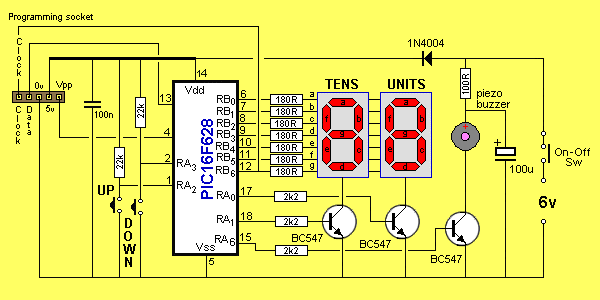
Alarm buzzer sounds when 00 on Displays
Going Further
This program/project can be modified to carry out all sorts of tasks. One constructor wanted a Quiz Score with 3 single displays, three contestant switches and a reset button. The adjudicator could increase the individual score or decrease the score according to the answer. This project could be adapted to this application.
Another reader wanted to count from 35 to 80 and cycle around these two values. Again, this can be done by simply changing a few lines of code.
You can add a relay, buzzer, set of LEDs, globes and actuators to the project to create a valuable piece of industrial equipment.
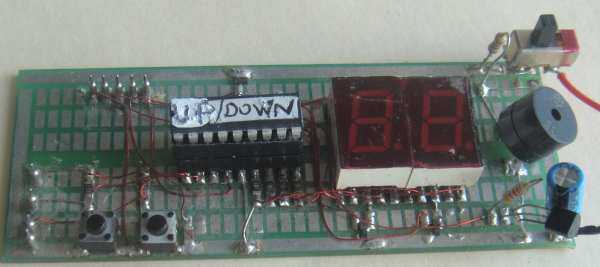
2 digit up/down counter with buzzer
Fast Increment
Another feature that can be added to the counter is fast-forward. Although it is not needed for this project, it is a sub-routine that can be added to other designs.
The way it works is this.
Each time the micro executes the FastUp sub-routine, a file is incremented. When the file reaches 100, the display is incremented at a rate of 5Hz.
The delay for the multiplexing routine is 10mS per display. This makes a total of 20mS. The counter detects 100 so the time before fast-increment occurs = 20mS x 100 = 2,000mS = 2 seconds.
FastUp sub-routine also needs a flag to detect when the fast increment is occurring. This is bit 7 of Sw_Flag. After the 2 second timing has occurred, the program increments the FastCount file for 5 loops to produce the fast increment function.
Here are the files:
If you use any of the following .asm files and find they fail to produce a .hex file, make sure you have the .inc file in the same folder as the .asm.
To add RESET to the up/down counter, add the following instructions:
SetUp bsf status,rp0
movlw b'00011100' ;Make RA0,1 out RA2,3,4 in
Put reset on RA4 pin3
put 22k to positive and the switch between pin3 and 0v.
When sw is pressed the input will go low.
in main, the least few lines will be
bcf Sw_Flag,2 ;button not pressed. Clear Up flag
bcf Sw_Flag,7 ;Clear Up repeat flag
clrf FastCount
btfss portA,4 ;test reset
goto SetUp
goto Main
END
;****************************************************************
;* Started 18/6/2009
;2 Digit UP / Down Counter with FastCount after 2secs
;Port B drives 7 segment display
;Up sw on RA2 Down on RA3
;Units drive on RA0 Tens drive on RA1 *
;* *
;****************************************************************
list P = 16F628 ;microcontroller
include ;registers for F628
__Config _cp_off & _lvp_off & _pwrte_on
& _wdt_off & _intRC_osc_noclkout & _mclre_off
;code protection - off
;low-voltage programming - off
;power-up timer - on
;watchdog timer - off
;use internal RC for 4MHz - all pins for in-out
;****************************************************************
; variables - names and files
;****************************************************************
;Files for F628 start at 20h
temp1 equ 20h ;for delay
temp2 equ 21h ;for delay
SwUp equ 22h ;
SwDwn equ 23h ;
units equ 24h ;
tens equ 25h ;
Sw_Flag equ 26h ;
FastCount equ 27h ;
;****************************************************************
;Equates
;****************************************************************
status equ 0x03
cmcon equ 0x1F
rp1 equ 0x06
rp0 equ 0x05
portA equ 0x05
portB equ 0x06
;****************************************************************
;Beginning of program
;****************************************************************
reset org 00 ;reset vector address
goto SetUp ;goto SetUp
table addwf PCL,F ;02h,1 add W to program counter
retlw b'00111111' ; "0" -|F|E|D|C|B|A
retlw b'00000110' ; "1" -|-|-|-|C|B|-
retlw b'01011011' ; "2" G|-|E|D|-|B|A
retlw b'01001111' ; "3" G|-|-|D|C|B|A
retlw b'01100110' ; "4" G|F|-|-|C|B|-
retlw b'01101101' ; "5" G|F|-|D|C|-|A
retlw b'01111101' ; "6" G|F|E|D|C|-|A
retlw b'00000111' ; "7" -|-|-|-|C|B|A
retlw b'01111111' ; "8" G|F|E|D|C|B|A
retlw b'01101111' ; "9" G|F|-|D|C|B|A
;****************************************************************
;* port A and B initialisation *
;****************************************************************
SetUp bsf status,rp0
movlw b'00001100' ;Make RA0,1 out RA2,3 in
movwf 05h ;trisA
clrf 06h ;trisB Make all RB output
bcf status,rp0 ;select programming area - bank0
movlw b'10000000' ;Turn off T0CKI, prescale for TMR0=1
movwf option_reg
clrf portB ;Clear Port B of junk
clrf units ;zero the units file
clrf tens ;zero the tens file
clrf Sw_Flag
movlw 07h ;turn comparators off and enable
movwf cmcon ; pins for I/O functions
goto Main
;****************************************************************
;* Delay 10mS 10 x 1,000uS *
;****************************************************************
D_10mS movlw 0Ah
movwf temp2
D_a nop
decfsz temp1,f
goto D_a
decfsz temp2,f
goto D_a
retlw 00
FastUp btfss Sw_Flag,2 ;First time through loop?
goto FU_2 ;yes
btfsc Sw_Flag,7 ;Has 5Hz bit been set?
goto FU_3
FU_1 incfsz FastCount,f ;Increment FastCount
movlw d'100'
xorwf FastCount,w
btfss status,2 ;reached 100 loops?
retlw 00
clrf FastCount
bsf Sw_Flag,7 ;set bit for 5Hz incrementing
FU_2 bsf Sw_Flag,2 ;Up button has been pressed
incf units,f
movlw 0Ah ;put 10 into w
xorwf units,w ;compare units file with 10
btfss status3,2 ;zero flag in status file. Set if units is 10
retlw 00
clrf units
incf tens,f
movlw 0Ah ;put 10 into w
xorwf tens,w ;compare units file with 10
btfsc status,2 ;zero flag in status file. Set if tens is 10
clrf tens
retlw 00 ;display passes 99 but not below 0
FU_3 incfsz FastCount,f ;Increment FastCount
movlw d'5'
xorwf FastCount,w
btfss status,2 ;reached 5 loops?
retlw 00
clrf FastCount
goto FU_2
Dwn btfsc Sw_Flag,3
retlw 00
bsf Sw_Flag,3
decf units,f
movlw 0FFh ;put FFh into w
xorwf units,w ;compare units file with FFh
btfss status,2 ;zero flag in status file. Set if units is 10
retlw 00
movlw 09
movwf units ;put 9 into units file
decf tens,f
movlw 0FFh ;put 0FFh into w
xorwf tens,w ;compare tens file with 0FFh
btfsc status,2 ;zero flag in status file. Set if tens is 0FFh
goto $+2 ;tens file is 0FFh
retlw 00
clrf tens
clrf units
retlw 00 ;display not below 0
;****************************************************************
;* Main *
;****************************************************************
Main btfss portA,2 ;test switch-press for UP
call FastUp ;UP switch pressed
btfss portA,3 ;test switch-press for Down
call Dwn ;Down switch pressed
movlw b'00000001' ;Make RA0 HIGH for units drive
movwf portA
movf units,w ;copy unit value into w
call table ;unit display value will return in w
movwf portB ;output units value
call D_10mS ;call delay
clrf portB ;clear display
movlw b'00000010' ;Make RA1 HIGH for tens drive
movwf portA
movf tens,w ;copy tens value into w
call table ;tens display value will return in w
movwf portB ;output tens value
call D_10mS ;call delay
clrf portB ;clear display
btfsc portA,3 ;bit will be zero when sw is pressed
bcf Sw_Flag,3 ;button not pressed. Clear down flag
btfss portA,2 ;bit will be zero when sw is pressed
goto Main
bcf Sw_Flag,2 ;button not pressed. Clear Up flag
bcf Sw_Flag,7 ;Clear Up repeat flag
clrf FastCount
goto Main
END
Secret Functions
This project can be extended to have “Secret Functions” that are accessed when the project is turned on.
By pressing the “Up” button and turning the project on, the project will turn into a “DICE PROJECT” and show a random number from 1 to 6 when the Up button is pressed.
When the “Down” button is pressed and the project is turned on, it will randomly show a number from 00 to 99 when the Up button is pressed.
Firstly we will describe the instructions that look at the buttons when the project is turned on.
The following instructions are added to the SetUp routine:
SetUp . . . . . .
. . . . . .
goto AAA ;Button A detected for DICE (detects LOW)
btfsc portA,3
goto Main
clrf Count
goto Random ;Button B detected
These programs are covered on page 2:
Quick Links
Legal Stuff
Social Media


